 |
|
Here and There introduces art, artists, galleries, museums, and other cultural facilities around Japan that non-Japanese readers and first-time visitors may find of particular interest.
|
|
 |
|
|
 |
 |
School of Rock: The Subterranean Museum of Oya
Alan Gleason |
 |
Sunlight pours through a gap in the quarry wall. Photo courtesy of Oya History Museum |
The first hint that there is something different about Oya comes when you turn off the highway down a side road and find yourself winding through a landscape of sheer rocky white cliffs, many showing the scars of quarrying. This is the Oya tuff zone, a unique protrusion of volcanic rock that measures only four by six kilometers in area, but whose quarries once yielded 900,000 tons of the rhyolitic tuff known as Oya stone every year. Long a coveted construction material for its fortuitous mix of strength, softness, and fire resistance, the stone is also attractive. Its mottled surface and greenish-gray hue caught the eye of the American architect Frank Lloyd Wright, who made Oya stone famous when he used it to build the original Imperial Hotel in Tokyo.
Though dramatic in their own right, the cliffs of Oya sit atop an even more surreal world. The ground under them is riddled with vast, high-ceilinged chambers from which the stone was mined, first by hand and later by machine. Demand declined as concrete became the material of choice for Japan's postwar building boom, and today the area produces a mere fraction of its past output, but the abandoned vaults remain. Happily, a section of one of the largest quarries was opened to the public in 1979 (the mining there halted for good in 1986). The site is now known as the Oya History Museum, a bit of a misnomer for a place that rivals some of the world's most celebrated caverns in grandeur, and has been made similarly visitor-friendly with the installation of staircases and lighting.
 |
|
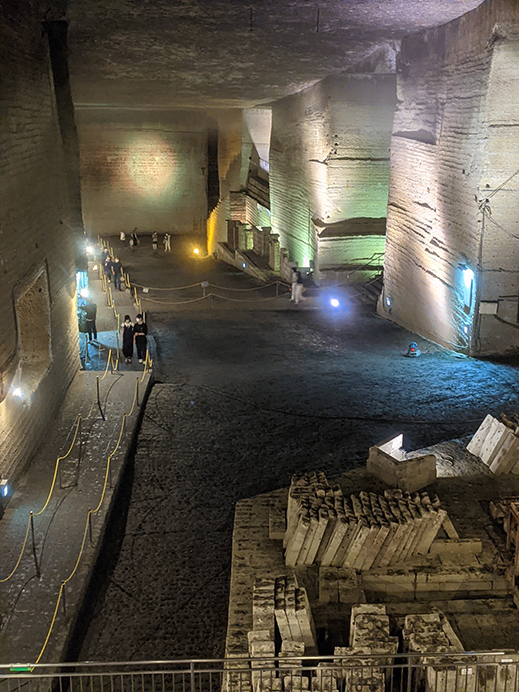 |
|
|
|
|
The road to the museum winds below cliffs carved by past quarrying. Photo courtesy of the Oya History Museum
|
|
A view of the first chamber from the top of the stairs. Stacks of cut stone appear to lie where they were when mining operations ceased. Photo by Kaoru Moriyama |
From the bus stop and parking lot, the road to the museum is enclosed in looming cliffs, etched at sharp angles that make you feel like you are strolling through a sculpture garden for giants. It's almost anticlimactic when you finally reach the entrance to the museum, a nondescript building at the end of the valley that gives no hint of the wonders below. After paying your admission, though, you need only descend a short flight of steps before the passage opens out upon a stunning view of the vast galleries below. Once you reach the floor -- 30 meters below ground level -- a series of well-marked, well-lit walks guide you through a seemingly endless labyrinth of chambers at different levels, connected by an Escherian network of staircases and ramps.
There are plenty of signs and charts, many in English, explaining what you are looking at. A map of the mine reveals that the "museum" is only one section of an underground quarry, 20,000 square meters wide, that produced 300,000 cubic meters of Oya stone over its seven decades of operation. Towering ten-meter-square pillars of stone, left in place at strategic intervals, keep the whole thing from caving in. Some galleries are the size of an airplane hangar -- and indeed, aircraft were built here during World War II -- while others have the dimensions and aura of a cathedral or a small chapel. Everywhere lighting in a variety of hues has been arranged with considerable artistry. Enhancing the visuals are the quarry walls themselves, which bear the geometric marks of chisels and power saws in patterns that recall certain genres of abstract art. Occasionally one stumbles on a corner where some mysterious piece of equipment left over from the mining days stands sentinel like a work of contemporary sculpture.
 |
|
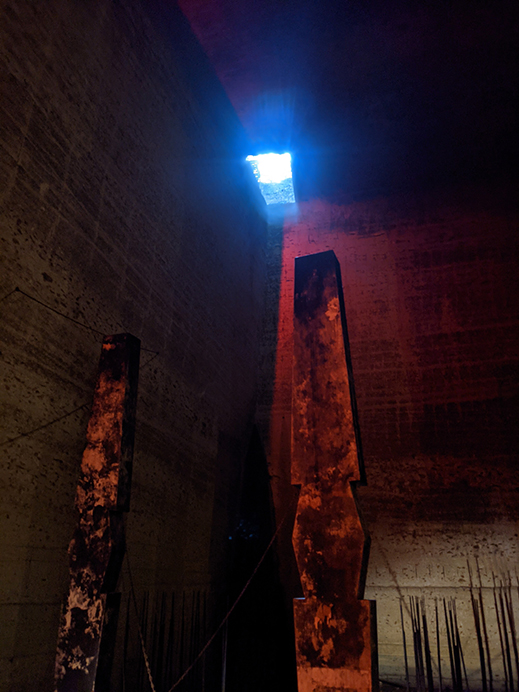 |
|
|
|
Left: Turn a corner and one encounters grottoes like this one, where indirect lighting and odd juxtapositions of surfaces frame the eerie shadow of a fissure in the wall. Right: Remnants of uncertain function from the quarrying process, these obelisk-like forms add to the sensation that one is standing in an ancient Egyptian temple. A bit of sky and foliage can be seen high above. Photos by Kaoru Moriyama |
The Oya History Museum's curators are well aware of the artistic and architectural appeal of their property, and have inserted some actual "art" into the ambience, notably a large composition of red sticks splayed in an ikebana-like layout, as well as an actual floral arrangement, equally massive, each occupying its own gallery. Both are by the celebrity ikebana artist Shogo Kakiyazaki. The museum also leases the place out to wedding parties and makers of films, TV dramas, commercials, and music videos; J-pop fans can enjoy a video digest of some of their favorite bands miming and posing on an underground stage backed by a soaring wall of stone.
Overall, though, the place is less commercialized than it could easily be, and none of the accoutrements of civilization detract from the awe-inducing experience of strolling through these aisles and aisles of subterranean glory. Here and there, openings in the ceiling offer glimpses of greenery and sky, with the occasional sudden shaft of sunlight. It's not only gorgeous, but a reminder of how far under the surface you are standing.
 |
|
 |
|
|
|
|
In one of the largest chambers, the floor is a ramp that was once used to haul stones -- and, during the war, aircraft frames. Photo courtesy of the Oya History Museum
|
|
Markings left by circular saw blades create patterns in the quarry wall. Photo by Kaoru Moriyama |
Though it takes less than an hour to walk through all of the chambers and corridors, it is hard to shake the unnerving feeling that these spaces go on forever, and that one wrong turn could find you hopelessly lost. One reason you might want to dawdle a bit before returning to the surface of the planet is the cavern's deliciously cool temperature, which averages 8℃ year-round. On a recent scorching August afternoon, it was 34℃ outside the entrance but 13℃ down in the depths.
That temperature differential is surely part of the site's popularity in summer. On the day I visited, the large parking lot was nearly full and the parade of visitors gave the place an amusement-park vibe. Fortunately for the crowd-averse in these pandemic times, the underground spaces are so vast, and well-ventilated, that they felt extremely safe and not crowded at all.
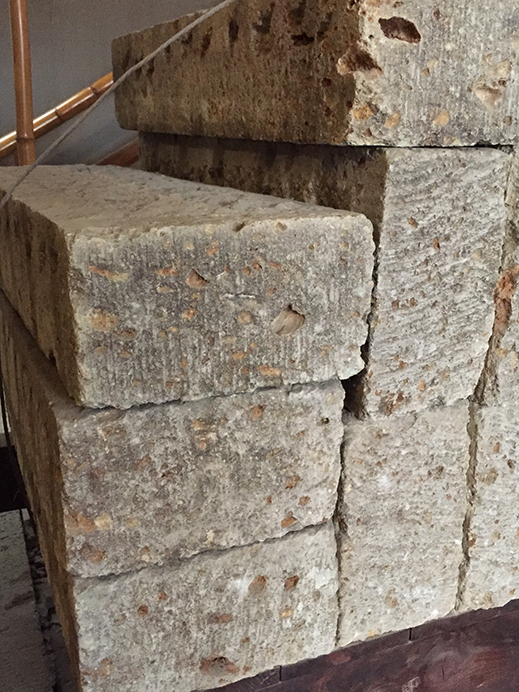 |
|
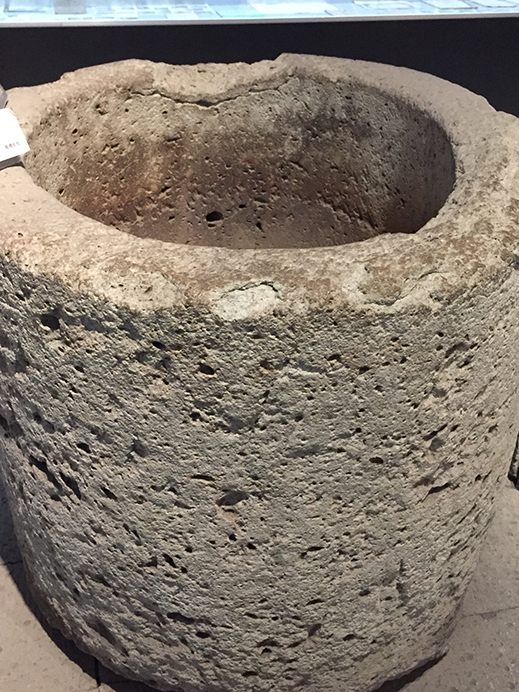 |
|
|
|
Left: A stack of quarried Oya stones, cut to the traditional dimensions of 15 x 30 x 90 cm. Right: A cistern made of Oya stone, on display in the Oya History Museum gallery. Photos by Alan Gleason |
The museum building up top includes a gallery that is a bit more cramped, chock-a-block as it is with exhibits about the quarry. Among them are a very helpful 3D model of the mine; photos and diagrams showing how it was excavated; hand tools and machines used for the digging, cutting, and hauling; samples of the different types and sizes of cut stone; and local archaeological finds demonstrating how the stone has been used in the area since ancient times to make everything from gate posts to water cisterns. One corner is devoted to Wright and his Imperial Hotel, which famously survived the Kanto Earthquake of 1923 when it struck on the hotel's opening day -- thanks not least to its Oya-stone construction. (This historic structure was unceremoniously replaced in 1968 by a generic high-rise hotel, but a portion of it survives in Meiji Mura, an outdoor architectural museum near Nagoya. You can see a video about it here.)
|
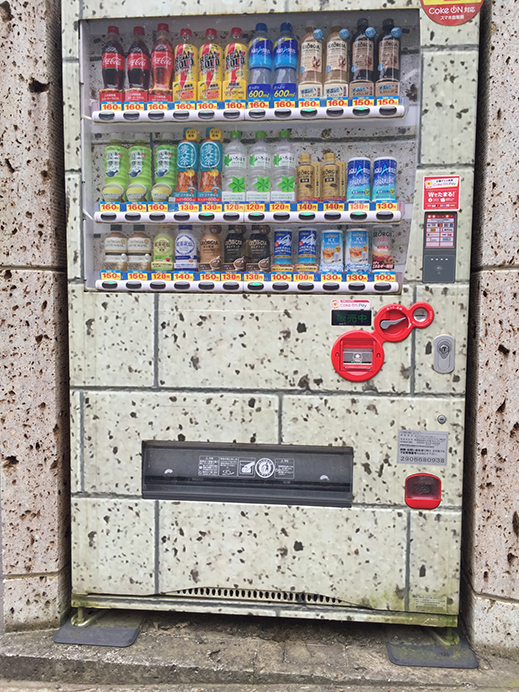 |
|
|
|
Even the vending machines in Oya get the stone treatment. Photo by Alan Gleason
|
Flanking the plaza outside the museum building is a large gift shop full of knickknacks made of Oya stone, of course, as well as a nicely appointed café. As one strolls the grounds, part of the fun is spotting the ways in which the Oya stone "look" has been incorporated into all manner of objects. The most ingenious, perhaps, is a soft-drink vending machine done up to look like something out of "The Flintstones."
The museum environs contain a number of mines still in operation, but most of the area is given over to tourism, with landscaped parks under the cliffs and a historic temple, Oya-ji, with an image of the bodhisattva Kannon carved into a cliff face. Just down the road is another, even larger, stone statue of the same deity, the 27-meter-high "Peace Kannon."
The Oya district is a few miles west of downtown Utsunomiya, a good-sized city that is the capital of Tochigi Prefecture. Though better known for its gyoza potstickers and thriving jazz scene, Utsunomiya also boasts several fine examples of Oya-stone architecture, among them the Matsugamine Catholic Church and the Byobuiwa Stone Warehouse. Utsunomiya is only an hour due north of Tokyo by expressway or Shinkansen bullet train.
All photos by permission of the Oya History Museum. |
 |
| Oya History Museum |
909 Oyamachi, Utsunomiya City, Tochigi Prefecture
Phone: 028-652-1232
Hours: (April - November) 9 a.m. to 5 p.m. (last admission 4:30 p.m.)
(December - March) 9:30 a.m. to 4:30 p.m. (last admission 4 p.m.)
Closures: (April - November) open every day
(December - March) closed every Tuesday (or the next day if Tuesday is a national holiday) and 27 December - 1 January
Access: (Car) 20 minutes from Kanuma interchange or 12 minutes from Utsunomiya interchange on the Tohoku Expressway
(Train and bus) Take the Oya/Tateiwa bound bus for 30 minutes from West Exit 6, JR Utsunomiya Station, or the Oya/Tateiwa bound bus for 20 minutes from Tobu Utsunomiya Station
|
| Oya Stone Synergy |
| (This excellent English-language website hosted by the local Oya Stone Guild contains everything you want to know about Oya stone.)
|
|
|
|
| |
 |
Alan Gleason
Alan Gleason is a translator, editor and writer based in Tokyo, where he has lived for over 30 years. Since 2006 he has edited artscape Japan and written the Here and There column, as well as translating the Picks reviews. He also edits and translates works on Japanese architecture, music, and theater. |
|
|
|
|
|
|
|
|
|
 |
|